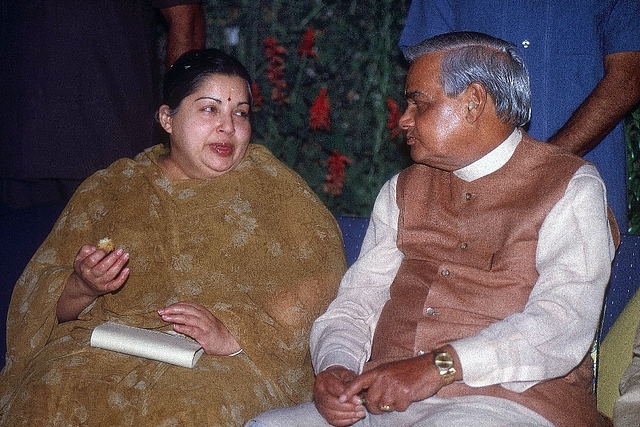
How Vajpayee Government Was Defeated By A Single Vote In 1999
Vajpayee will go down in Indian history, among a lot of other things, as a prime minister who lost Parliament’s trust by a single vote. Here’s how that came about.
Records show 17 April 1999 as a day when the Atal Bihari Vajpayee government lost the confidence of Parliament by a single vote (269-270). But what many might not know is the role of a couple of persons from Tamil Nadu in bringing down Vajpayee again in 13 months time. The first time, he had to quit within 13 days of assuming power, knowing well he wouldn’t get the required support to keep his government going.
The momentum for the 1999 voting out of the Vajpayee government was built at a tea party organised by now Bharatiya Janata Party (BJP) Rajya Sabha member Subramanian Swamy. One of the key constituents of Vajpayee’s government, the All India Anna Dravida Munnetra Kazhagam (AIADMK) leader J Jayalalithaa came face to face with then-Congress leader Sonia Gandhi to join hands and pull down the government at the party that was held on 29 March that year.
Exactly a fortnight later, Jayalalithaa came back to New Delhi to pull the plug on the Vajpayee government. On 14 April, Tamil New Year’s Day, Jayalalithaa called on then-president K R Narayanan to give him a letter withdrawing support to the Vajpayee government. Vajpayee and the BJP were then asked to prove that they enjoyed a majority in Parliament, what with the late Pramod Mahajan moving heaven and earth to get the numbers.
When 17 April dawned, Vajpayee was almost sure to scrape through. The Bahujan Samaj Party (BSP), with its five members, had assured they would vote in favour of Vajpayee. But just before the vote of confidence, the BSP leader in Lok Sabha, Mayawati, rose and said her party would be voting against the BJP. That was a nasty surprise catching the BJP, Vajpayee and, of all, Mahajan by surprise. What happened between 16 April evening and the dawn next day?
Jayalalithaa, who was keen to bring down the Vajpayee government since the then-prime minister was unwilling to accommodate her demand of allocating a key subject in the Finance Ministry to her member and minister of state in the Finance Ministry, chose to tap her Tamil connections to spring a surprise. She got her aide Sasikala’s husband, Natarajan, to reach out to the personal secretary of late Kanshi Ram, who hailed from Tamil Nadu. Natarajan and the secretary were friends. A deal was struck and the BSP decided to vote against the AIADMK. (Delhi was agog with discussions of how AIADMK had struck the deal on a per-BSP MP basis!). That turned the table against Vajpayee.
Actually, the electronic system was used for voting, and there was confusion. The board showed Vajpayee losing the confidence vote, but the numbers didn’t tally. Then, the House speaker had to include the votes given to him in chits from members whose systems didn’t work. When the numbers all tallied, the BJP government missed the bus by a single vote.
Vajpayee could have survived this sudden turn of events but for two more things that happened. First, Saifuddin Soz chose to vote against his then-party National Conference’s diktat to favour Vajpayee. Next was an unpardonable act of the Congress. Giridhar Gamang, who was a member of Lok Sabha, was elected Orissa (now Odisha) chief minister on 17 February 1999. He had not resigned his membership in Lok Sabha when the vote of confidence was taken up. Therefore, he came to the House to be along with his Congress colleagues and vote against Vajpayee.
Gamang lasted another seven months before he lost office. Ironically, he joined the BJP in 2015. Had Gamang not voted, it could have been 269 all and the speaker G M Bala Yogi would have certainly cast his decisive vote in favour of Vajpayee. But that was not to be; Vajpayee will go down in Indian history also as a prime minister who lost Parliament’s trust by a single vote.
Must-read stories on Vajpayee:
Atal Bihari Vajpayee (1924-2018)
Vajpayee: A Great Statesman In The ‘Right’ Party
Atal Bihari Vajpayee, The Man Who Mainstreamed BJP And Bharatiyata